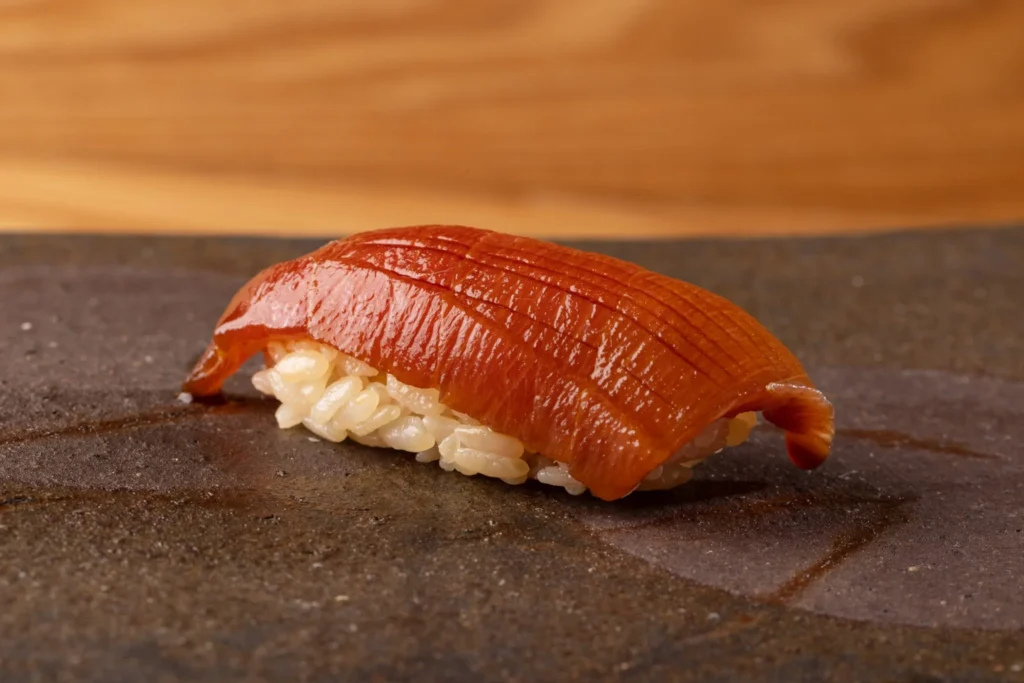The charm of sushi
In Japan, the tradition of eating sushi for life’s milestones and celebrations is deeply ingrained.
Even in an age where conveyor belt sushi (kaiten-zushi) offers plates for just a few hundred yen, why do people choose high-end sushi restaurants, often spending over 10,000 yen per person, for special occasions?
This article explores the allure of luxury sushi, which stands in stark contrast to conveyor belt sushi, and delves into the reasons why Japanese people are willing to pay a premium for it on important days.
Japanese culture places a high value on tradition and ritual, a tendency particularly evident during celebrations. Sushi, with its long history in Japan, has been associated with special occasions as a symbol of good fortune.
The choice of expensive sushi for celebrations, despite the availability of more affordable alternatives like conveyor belt sushi, suggests a deeper meaning behind this selection, which we will thoroughly investigate.
Table of Contents
The Deep Connection Between Celebrations and Sushi in Japan
In Japan, there’s a long-standing custom of eating sushi during celebrations and on special days.
This goes beyond mere eating habits; the kanji character for “sushi” can be interpreted as “寿 (kotobuki – longevity/felicity)を司る (tsukasa-doru – to govern/manage),” making it an auspicious food eaten frequently at celebratory gatherings to wish for long life and happiness.
For instance, historical records show sushi being offered as tribute to the imperial court during the Nara period.
While nigiri sushi became popular among commoners during the Edo period, it was also recognized as a high-end dish served at celebratory events.
Thus, sushi has held a special meaning in Japanese food culture, transcending its role as an everyday meal.
Chirashi sushi, in particular, with its vibrant colors and beautiful presentation, is an essential dish for celebrations like Hinamatsuri (Girls’ Day).
Chirashi sushi consists of vinegared rice topped with various ingredients, its flamboyant appearance making it suitable for festive occasions.
Each ingredient also carries symbolic meaning; for example, shrimp symbolizes longevity, and lotus root represents clear foresight. Furthermore, sea bream (tai) is often used at celebrations due to its phonetic similarity to the word “medetai” (auspicious/happy).
As these examples illustrate, sushi is deeply intertwined with Japanese culture and tradition, chosen for celebrations not just for its delicious taste, but also for its symbolic meaning of good fortune.
The Allure of High-End Sushi: Why Do People Pay a Premium?
Exquisite, Carefully Selected Ingredients
High-end sushi restaurants procure the finest ingredients of the day, using wild-caught and rare, premium seafood meticulously selected by expert buyers at the market.
Through long-standing relationships with seafood wholesalers and even personal visits to fishing regions by the chefs themselves, they secure the highest quality fish and shellfish.
For example, at Sushi Kirimon in Osaka, they might use top-grade tuna that costs over 40,000 yen per kilogram, sea urchin that can exceed 100,000 yen for a single piece, or large Beluga caviar at 50,000 yen per 50 grams.
These ingredients are then carefully prepared by skilled artisans and served in their optimal condition.
Their value lies not just in their high price, but also in their rarity and superior quality, making them perfectly suited for a special meal.
The Skill and Soul of a Master Sushi Chef
The true essence of high-end sushi lies not just in using good ingredients, but in the extraordinary techniques of chefs who have undergone years of rigorous training.
From the selection of rice for the shari (sushi rice) to its cooking and the blending of vinegars, the chef’s experience and skill play a crucial role.
Every detail, including the type of rice, water quantity, cooking time, and the blend of several types of vinegar, contributes to creating perfectly seasoned rice that melts in your mouth.
The delicate art of adjusting the knife work, the pressure of the grip, and the balance with the shari according to the type of topping is something that cannot be mastered overnight.
By discerning the type and condition of the fish and preparing it with the optimal thickness and cut, they maximize the inherent deliciousness of the ingredients.
Beyond simply slicing raw fish, consider kohada (gizzard shad); this fish changes names as it grows from a young “shinko,” and its preparation requires the chef’s experience and intuition for the right amount of salt and vinegar and the soaking time.
There are also toppings like kizushi (vinegared mackerel) that involve time-consuming preparation like curing with vinegar.
Furthermore, techniques like steaming and then grilling anago (conger eel) or unagi (freshwater eel) create a fluffy texture and fragrant flavor, demonstrating the meticulous work tailored to the characteristics of each ingredient.
Even dishes like chawanmushi (savory steamed egg custard), where dashi (broth) is carefully made over a long time from bonito and kelp, exemplify the dedication unique to high-end sushi restaurants.
Chefs meticulously craft each piece, putting their soul into every nigiri, to bring out the best in the ingredients. The value placed on their skill and experience is a significant component of high-end sushi’s price.
A Special Experience for All Five Senses
A high-end sushi restaurant is more than just a place to eat; it’s a space where you can indulge in a special experience with all five senses.
The calm, sophisticated ambiance, conversation with the chef, and the live performance of food preparation offer an element of entertainment.
A counter made of pristine white wood, refined interiors, and the quiet flow of time create an extraordinary atmosphere that helps you forget the hustle and bustle of daily life.
Engaging in conversation with the chef, learning about ingredients and preparation methods, or getting recommendations are also unique pleasures of high-end sushi.
Each piece of sushi, meticulously served, captivates diners through its beauty, aroma, texture, and taste.
The unique flavors and textures of each topping, combined with the exquisite balance with the shari, create moments of pure bliss that make you feel the high price is truly worth it.

Clear Distinctions from Conveyor Belt Sushi: Quality, Skill, and “Value”
While conveyor belt sushi offers convenience and affordability, there are clear distinctions from high-end sushi in terms of ingredient quality, chef’s skill, and the overall experience.
Conveyor belt sushi often uses frozen or farmed ingredients to keep costs down, and the shari is typically machine-pressed.
In contrast, high-end sushi restaurants prioritize wild-caught ingredients, and chefs hand-form each piece of shari.
This difference is evident in the taste and texture.
For example, with tuna, high-end sushi restaurants might age it for several days to enhance its umami, while conveyor belt sushi is often served immediately to maintain freshness.
High-end sushi restaurants also pay close attention to condiments like wasabi and soy sauce.
For instance, they might use different types of wasabi or soy sauce aged in wooden barrels to bring out the best in each topping.
This attention to detail significantly enhances the flavor of high-end sushi. Such meticulous considerations are generally absent in conveyor belt sushi.
| Feature | High-End Sushi | Conveyor Belt Sushi |
| Ingredient Quality | Fresh, wild-caught, expertly selected by experienced connoisseurs | Often uses frozen or farmed ingredients to reduce cost |
| Chef’s Skill | Years of training, meticulous preparation, hand-formed shari | Generally machine-pressed shari |
| Condiments | High-quality, varied according to topping (e.g., several types of wasabi, wooden barrel soy sauce) | Standard condiments |
| Dining Experience | Refined ambiance, conversation with chef, multi-sensory experience | Casual and convenient dining |
| Price (per person) | 10,000 yen – 20,000+ yen | Around 3,000 yen (from user’s question) |
The amount paid for high-end sushi is not just the cost of a meal; it’s the price for a special moment, the chef’s skill, and the value of exquisite ingredients.
While conveyor belt sushi offers convenience and cost-effectiveness, on special occasions, Japanese people choose high-end sushi for higher quality ingredients, the chef’s artistry, and a memorable experience.
Why High-End Sushi is Chosen for Anniversaries and Celebrations
It’s natural to want a special meal different from the everyday for life’s significant milestones and celebrations, such as wedding anniversaries, birthdays, or promotions.
High-end sushi, with its prestige and luxury, is chosen as a fitting meal for these “hare no hi” (special, celebratory days).
Savoring sushi made with premium ingredients that are usually out of reach will make a special day even more memorable.
The desire to enrich special moments spent with loved ones—family, partners, or friends—is another significant reason why high-end sushi is chosen.
The experience of savoring sushi prepared by a chef right in front of you in an elegant setting creates a special memory that transcends the ordinary.
Sharing delicious food with important people in a unique space is invaluable.
Furthermore, for business entertainment, such as hosting superiors, high-end sushi is an optimal choice due to its prestige.
The beautiful sushi, showcasing the chef’s skill, and the meticulous hospitality convey respect and gratitude to the guest.
In a business context, not only the quality of the food but also the restaurant’s ambiance and service are crucial, and high-end sushi establishments excel in providing these elements.
Examples of High-End Sushi in Osaka
http://www.sushi-hiromi.jp/Osaka, particularly around Kitashinchi, is home to many high-end sushi restaurants.
For example, Sushi Kirimon offers the “Gokudate OMAKASE Course,” recognized by Guinness World Records at 350,000 yen, allowing diners to indulge in the finest ingredients and the chef’s masterful techniques.
This course generously uses rare ingredients, offering the ultimate sushi experience.
On the other hand, hidden gems like Renshin offer high-end sushi courses with all-you-can-drink for around 10,000 yen, catering to those who seek a relatively affordable yet luxurious sushi and drink experience.
Additionally, there are many other high-end sushi restaurants with unique characteristics, including Sushi Ayase, Premium Marche with Sushi Nakagawa, Sushi Hiromi, Senba Hechimonya, and Senba Awajimachi Yoshino Sushi.
Each of these establishments has its own distinct philosophy, providing visitors with a unique sushi experience.
High-end sushi is not just expensive; it offers value that conveyor belt sushi can never provide: carefully selected ingredients, the skill of master chefs, and an exclusive experience.
The reason Japanese people are willing to pay a premium for high-end sushi on important anniversaries and celebrations is that they are seeking more than just a meal-they desire a memorable, special time and experience.
It is a reflection of the Japanese aesthetic and values, which aspire to adorn life’s special moments with the finest cuisine and ambiance.
What kind of special occasion would you consider enjoying high-end sushi for?

